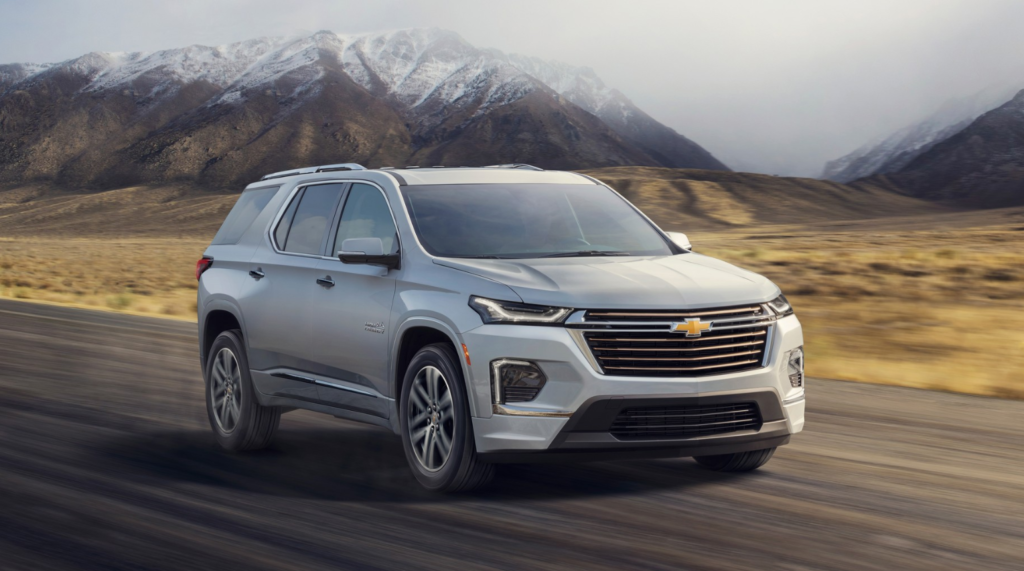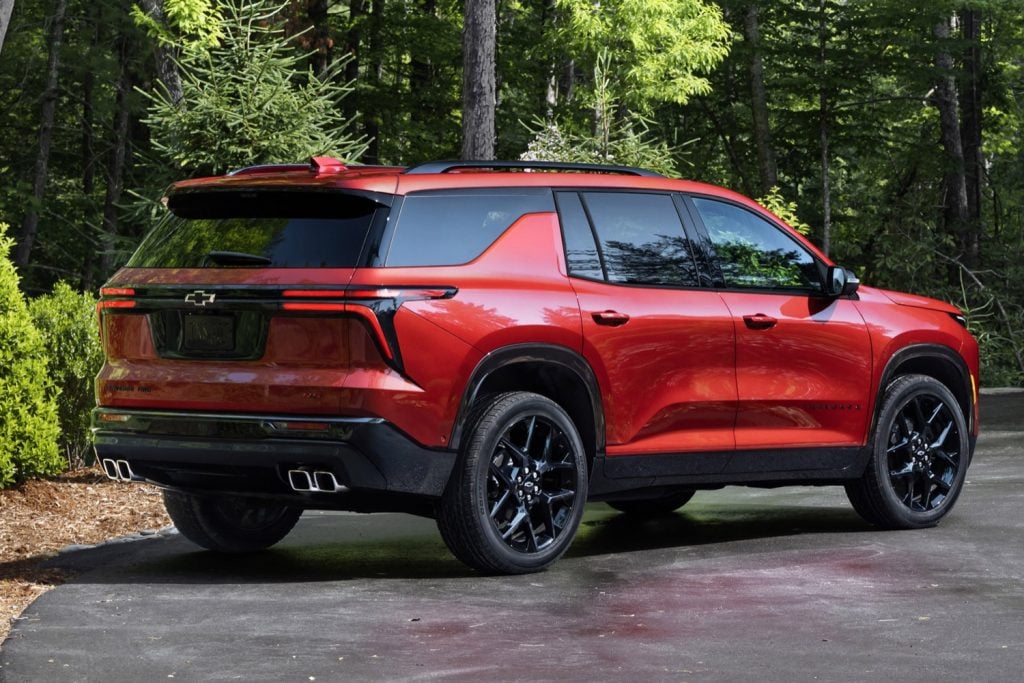The 2025 Chevrolet Traverse: A Look at Safety and Performance
The 2025 Chevrolet Traverse: A Look at Safety and Performance
Introduction
With enthusiasm, let’s navigate through the intriguing topic related to The 2025 Chevrolet Traverse: A Look at Safety and Performance. Let’s weave interesting information and offer fresh perspectives to the readers.
Table of Content
The 2025 Chevrolet Traverse: A Look at Safety and Performance

The 2025 Chevrolet Traverse, a popular mid-size SUV, is set to enter the market with a host of updated features and technologies. One of the key aspects that will influence consumer decisions is the vehicle’s safety performance, as measured by independent crash testing agencies like the National Highway Traffic Safety Administration (NHTSA) and the Insurance Institute for Highway Safety (IIHS). While specific ratings are not yet available for the 2025 model year, we can analyze the safety features and technologies offered in the Traverse to understand its potential performance in these tests.
Understanding Crash Test Ratings
Crash test ratings are essential tools for consumers when evaluating vehicle safety. They provide an objective assessment of a vehicle’s ability to protect its occupants in the event of a collision. These ratings are based on rigorous testing procedures that simulate real-world crash scenarios.
-
NHTSA Ratings: The NHTSA assigns overall vehicle safety ratings based on five categories: frontal crash, side crash, rollover, head restraint, and overall vehicle score. Each category receives a rating from one to five stars, with five stars indicating the highest level of protection.
-
IIHS Ratings: The IIHS evaluates vehicles based on six crashworthiness tests: driver-side small overlap front, passenger-side small overlap front, moderate overlap front, side, roof strength, and head restraints. Each test receives a rating of "Good," "Acceptable," "Marginal," or "Poor," with "Good" representing the highest level of performance.
Safety Features of the 2025 Chevrolet Traverse
The 2025 Chevrolet Traverse is expected to build upon the safety features already present in the current model, incorporating advancements in active safety technology and driver assistance systems. Here’s a glimpse into what we can anticipate:
-
Advanced Airbags: The Traverse will likely feature an array of airbags, including front, side, curtain, and driver’s knee airbags, to provide comprehensive protection in various crash scenarios.
-
Electronic Stability Control (ESC): ESC is a standard feature that helps maintain control of the vehicle during sudden maneuvers or slippery road conditions, preventing potential skidding or rollovers.
-
Anti-lock Braking System (ABS): ABS helps prevent wheel lockup during braking, allowing drivers to maintain steering control and avoid skidding.
-
Lane Departure Warning (LDW): This system alerts drivers if the vehicle drifts out of its lane without signaling, helping to prevent accidents caused by driver inattention.
-
Forward Collision Warning (FCW): FCW uses sensors to detect potential collisions with vehicles ahead and warns drivers to take corrective action.
-
Automatic Emergency Braking (AEB): AEB systems can automatically apply the brakes to prevent or mitigate collisions, particularly in situations where drivers fail to react in time.
-
Adaptive Cruise Control (ACC): ACC helps maintain a safe distance from vehicles ahead, automatically adjusting speed to keep pace with traffic flow.
-
Blind Spot Monitoring (BSM): BSM uses sensors to detect vehicles in the driver’s blind spots and alerts them with visual or auditory cues.
-
Rear Cross Traffic Alert (RCTA): RCTA assists drivers when reversing out of parking spaces by alerting them to approaching vehicles that may be difficult to see.
-
Teen Driver Technology: This feature allows parents to monitor their teen driver’s driving habits, setting limits on vehicle speed and audio volume, and providing feedback on driving performance.
Factors Influencing Crash Test Ratings
While the specific safety features of the 2025 Chevrolet Traverse are promising, several factors can influence its final crash test ratings:
-
Vehicle Structure: The Traverse’s structural integrity, including its frame, crumple zones, and safety cage, will play a significant role in its performance in crash tests.
-
Safety Technology Calibration: The effectiveness of active safety systems like AEB and LDW will depend on their calibration and ability to accurately detect and respond to potential hazards.
-
Testing Methodology: The NHTSA and IIHS have specific testing protocols and procedures that are continuously evolving. Any changes in these methodologies could impact the ratings of vehicles.
The Importance of Crash Test Ratings
Crash test ratings are crucial for consumers because they provide independent and objective information about a vehicle’s safety performance. This information empowers consumers to make informed decisions about their vehicle purchases, prioritizing safety alongside other factors like price, fuel efficiency, and comfort.
FAQs about the 2025 Chevrolet Traverse Crash Test Ratings
1. When will the 2025 Chevrolet Traverse crash test ratings be available?
Crash test ratings for the 2025 model year will likely be released by the NHTSA and IIHS shortly after the vehicle’s official launch.
2. How important are crash test ratings?
Crash test ratings are vital for consumers as they provide a standardized measure of a vehicle’s safety performance, allowing for direct comparison between different models.
3. Are all crash test ratings equal?
While both the NHTSA and IIHS conduct rigorous crash testing, their methodologies and rating scales differ slightly. It’s essential to consider both sets of ratings for a comprehensive understanding of a vehicle’s safety performance.
4. What are some other safety features to look for in a vehicle?
In addition to crash test ratings, consider other safety features like rearview cameras, parking sensors, lane keeping assist, and driver attention monitoring systems.
5. Can I rely solely on crash test ratings when choosing a vehicle?
While crash test ratings are crucial, they should be considered alongside other factors like driver behavior, vehicle maintenance, and road conditions.
Tips for Choosing a Safe Vehicle
-
Research crash test ratings: Refer to the NHTSA and IIHS websites for the latest ratings on vehicles you’re considering.
-
Consider safety features: Look for vehicles with a comprehensive suite of active and passive safety features.
-
Test drive the vehicle: Take the vehicle for a test drive to experience its handling, braking, and overall performance.
-
Read reviews: Consult online reviews and automotive publications for insights into a vehicle’s safety performance and reliability.
-
Discuss safety features with a dealer: Ask the dealer about specific safety features and technologies available in the vehicle.
Conclusion
The 2025 Chevrolet Traverse is poised to offer a compelling combination of safety, technology, and practicality. While specific crash test ratings are yet to be released, the vehicle’s anticipated safety features and the importance of independent testing agencies like the NHTSA and IIHS make it a strong contender in the mid-size SUV segment. By considering crash test ratings and other safety features, consumers can make informed decisions about their vehicle purchases, ensuring they prioritize safety and peace of mind for themselves and their passengers.








Closure
Thus, we hope this article has provided valuable insights into The 2025 Chevrolet Traverse: A Look at Safety and Performance. We hope you find this article informative and beneficial. See you in our next article!